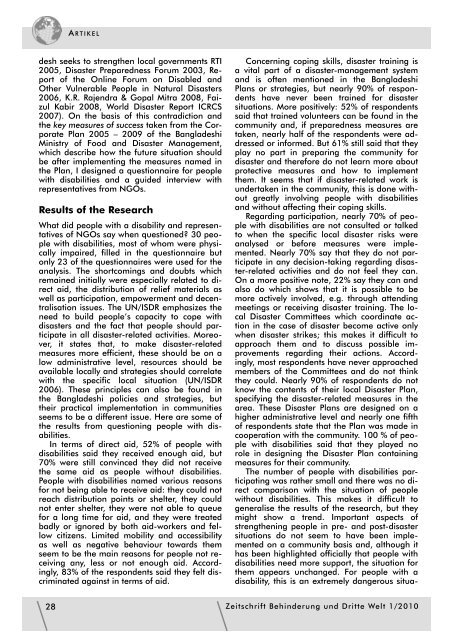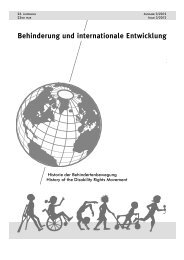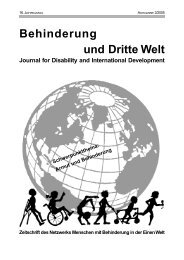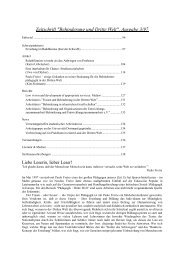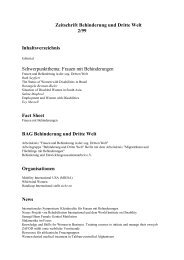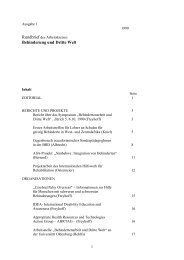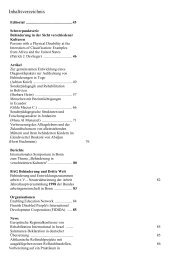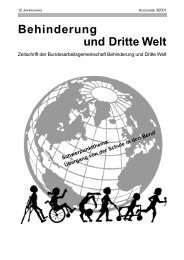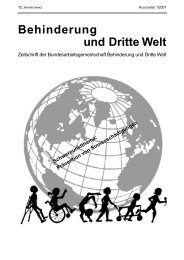Disaster and Disability in Bangladesh - Behinderung und Dritte Welt
Disaster and Disability in Bangladesh - Behinderung und Dritte Welt
Disaster and Disability in Bangladesh - Behinderung und Dritte Welt
Create successful ePaper yourself
Turn your PDF publications into a flip-book with our unique Google optimized e-Paper software.
A RTIKELdesh seeks to strengthen local governments RTI2005, <strong>Disaster</strong> Preparedness Forum 2003, Reportof the Onl<strong>in</strong>e Forum on Disabled <strong>and</strong>Other Vulnerable People <strong>in</strong> Natural <strong>Disaster</strong>s2006, K.R. Rajendra & Gopal Mitra 2008, FaizulKabir 2008, World <strong>Disaster</strong> Report ICRCS2007). On the basis of this contradiction <strong>and</strong>the key measures of success taken from the CorporatePlan 2005 – 2009 of the <strong>Bangladesh</strong>iM<strong>in</strong>istry of Food <strong>and</strong> <strong>Disaster</strong> Management,which describe how the future situation shouldbe after implement<strong>in</strong>g the measures named <strong>in</strong>the Plan, I designed a questionnaire for peoplewith disabilities <strong>and</strong> a guided <strong>in</strong>terview withrepresentatives from NGOs.Results of the ResearchWhat did people with a disability <strong>and</strong> representativesof NGOs say when questioned? 30 peoplewith disabilities, most of whom were physicallyimpaired, filled <strong>in</strong> the questionnaire butonly 23 of the questionnaires were used for theanalysis. The shortcom<strong>in</strong>gs <strong>and</strong> doubts whichrema<strong>in</strong>ed <strong>in</strong>itially were especially related to directaid, the distribution of relief materials aswell as participation, empowerment <strong>and</strong> decentralisationissues. The UN/ISDR emphasizes theneed to build people’s capacity to cope withdisasters <strong>and</strong> the fact that people should participate<strong>in</strong> all disaster-related activities. Moreover,it states that, to make disaster-relatedmeasures more efficient, these should be on alow adm<strong>in</strong>istrative level, resources should beavailable locally <strong>and</strong> strategies should correlatewith the specific local situation (UN/ISDR2006). These pr<strong>in</strong>ciples can also be fo<strong>und</strong> <strong>in</strong>the <strong>Bangladesh</strong>i policies <strong>and</strong> strategies, buttheir practical implementation <strong>in</strong> communitiesseems to be a different issue. Here are some ofthe results from question<strong>in</strong>g people with disabilities.In terms of direct aid, 52% of people withdisabilities said they received enough aid, but70% were still conv<strong>in</strong>ced they did not receivethe same aid as people without disabilities.People with disabilities named various reasonsfor not be<strong>in</strong>g able to receive aid: they could notreach distribution po<strong>in</strong>ts or shelter, they couldnot enter shelter, they were not able to queuefor a long time for aid, <strong>and</strong> they were treatedbadly or ignored by both aid-workers <strong>and</strong> fellowcitizens. Limited mobility <strong>and</strong> accessibilityas well as negative behaviour towards themseem to be the ma<strong>in</strong> reasons for people not receiv<strong>in</strong>gany, less or not enough aid. Accord<strong>in</strong>gly,83% of the respondents said they felt discrim<strong>in</strong>atedaga<strong>in</strong>st <strong>in</strong> terms of aid.Concern<strong>in</strong>g cop<strong>in</strong>g skills, disaster tra<strong>in</strong><strong>in</strong>g isa vital part of a disaster-management system<strong>and</strong> is often mentioned <strong>in</strong> the <strong>Bangladesh</strong>iPlans or strategies, but nearly 90% of respondentshave never been tra<strong>in</strong>ed for disastersituations. More positively: 52% of respondentssaid that tra<strong>in</strong>ed volunteers can be fo<strong>und</strong> <strong>in</strong> thecommunity <strong>and</strong>, if preparedness measures aretaken, nearly half of the respondents were addressedor <strong>in</strong>formed. But 61% still said that theyplay no part <strong>in</strong> prepar<strong>in</strong>g the community fordisaster <strong>and</strong> therefore do not learn more aboutprotective measures <strong>and</strong> how to implementthem. It seems that if disaster-related work is<strong>und</strong>ertaken <strong>in</strong> the community, this is done withoutgreatly <strong>in</strong>volv<strong>in</strong>g people with disabilities<strong>and</strong> without affect<strong>in</strong>g their cop<strong>in</strong>g skills.Regard<strong>in</strong>g participation, nearly 70% of peoplewith disabilities are not consulted or talkedto when the specific local disaster risks wereanalysed or before measures were implemented.Nearly 70% say that they do not participate<strong>in</strong> any decision-tak<strong>in</strong>g regard<strong>in</strong>g disaster-relatedactivities <strong>and</strong> do not feel they can.On a more positive note, 22% say they can <strong>and</strong>also do which shows that it is possible to bemore actively <strong>in</strong>volved, e.g. through attend<strong>in</strong>gmeet<strong>in</strong>gs or receiv<strong>in</strong>g disaster tra<strong>in</strong><strong>in</strong>g. The local<strong>Disaster</strong> Committees which coord<strong>in</strong>ate action<strong>in</strong> the case of disaster become active onlywhen disaster strikes; this makes it difficult toapproach them <strong>and</strong> to discuss possible improvementsregard<strong>in</strong>g their actions. Accord<strong>in</strong>gly,most respondents have never approachedmembers of the Committees <strong>and</strong> do not th<strong>in</strong>kthey could. Nearly 90% of respondents do notknow the contents of their local <strong>Disaster</strong> Plan,specify<strong>in</strong>g the disaster-related measures <strong>in</strong> thearea. These <strong>Disaster</strong> Plans are designed on ahigher adm<strong>in</strong>istrative level <strong>and</strong> nearly one fifthof respondents state that the Plan was made <strong>in</strong>cooperation with the community. 100 % of peoplewith disabilities said that they played norole <strong>in</strong> design<strong>in</strong>g the <strong>Disaster</strong> Plan conta<strong>in</strong><strong>in</strong>gmeasures for their community.The number of people with disabilities participat<strong>in</strong>gwas rather small <strong>and</strong> there was no directcomparison with the situation of peoplewithout disabilities. This makes it difficult togeneralise the results of the research, but theymight show a trend. Important aspects ofstrengthen<strong>in</strong>g people <strong>in</strong> pre- <strong>and</strong> post-disastersituations do not seem to have been implementedon a community basis <strong>and</strong>, although ithas been highlighted officially that people withdisabilities need more support, the situation forthem appears unchanged. For people with adisability, this is an extremely dangerous situa-28 Zeitschrift Beh<strong>in</strong>derung <strong>und</strong> <strong>Dritte</strong> <strong>Welt</strong> 1/2010


